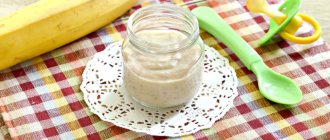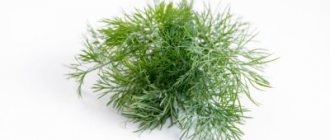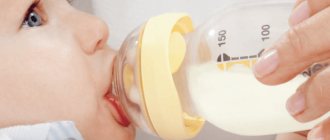What to feed your baby?, what to feed your baby
- The need for drinking in children of the first year of life is individual and determined by the nature of feeding, the age and weight of the child, his state of health, and climatic conditions. Let's talk about everything in order.
A baby who is exclusively breastfed does not need any additional fluid other than breast milk before complementary feeding is introduced. If the child is on mixed or completely artificial feeding, then additional drinks are prescribed by the doctor individually.
In general, the amount of fluid a baby consumes depends on his age and weight. A child under one year old needs 100 ml of fluid per day per 1 kg of body weight. When he weighs more than 10 kg, the calculation becomes more complicated: the child will need 1 liter of liquid per day plus 50 ml for every kilogram over 10 kg weight.
About water
High-quality water for baby food should have the characteristic properties of drinking water - transparency, odorlessness, and neutral taste. This can be freshly boiled tap water, previously passed through a household filter, or bottled water. Doctors often recommend using this type of water, because... During its production, all hygienic requirements are met and it is truly safe for the baby’s health. The main advantage of using bottled water is the guaranteed control of low mineralization levels. The composition of water significantly affects the quality of food, so pay attention to the following fact. Water for children is divided into two categories: water for recovery (i.e. for preparing baby food from dry formula) and drinking water. The mineral composition of drinking water slightly exceeds the permissible values for a newborn for basic micro- and macroelements, so it is recommended to give it to children older than six months and not to use it to dissolve dry foods. The recovery water is softer and is dual-use water. It is allowed for children from the first days of life.
There are some rules for using bottled water:
- Water must have the characteristic “children’s” in its name.
The label must include the name of the organization that provides the official medical report on the water. Today there are only three such organizations - the Ministry of Health of the Russian Federation, the State Sanitary and Epidemiological Supervision of the Ministry of Health of the Russian Federation and the Institute of Nutrition of the Russian Academy of Medical Sciences.
- Bottled water should not be boiled!
- Water should be stored at low temperature, in the refrigerator. Doctors advise focusing on the shelf life of baby juices being 48 hours. It is advisable to use an open bottle of water during the day, because... various microorganisms can get into it.
- Only non-carbonated water can be used in feeding young children. Therapeutic and prophylactic waters are also not suitable due to their high saturation with mineral salts.
About juices
Fruit and vegetable juices, compotes and vegetable decoctions are among the products that are included in the diet of children as a supplement to breast milk or its substitutes no earlier than 4 months. This allows you to provide the child with a number of new nutrients that he needs - glucose, fructose, organic acids, vitamin C, iron, potassium.
At home, you can prepare low concentration compotes from apples, pears, prunes and dried apricots. Vegetable decoctions are also useful. But, given the unfavorable environmental situation, doctors consider it advisable to introduce natural industrial juices into the baby’s diet, as well as juices squeezed from vegetables and fruits from your own garden, when you know that they were grown without the use of harmful chemicals. Industrially produced juices are used if the doctor has prescribed juices for a child over 4 months of age.
From 6 months you can use homemade juices. Almost all industrial juices are enriched with vitamin C in a dose of 15 to 100% of the daily requirement for this vitamin for children of the first year of life. Iron is also added to some juices, which helps prevent anemia in children.
Juices can be single-component or mixed. Blended juices have higher nutritional value than juices from a single fruit. But here lies the real danger of an allergic reaction, and it will be difficult to determine which component the baby’s body will react inadequately to.
Therefore, it is better to first introduce only single-component juices into the baby’s diet (from apples, pears, peaches, carrots, pumpkins), and when the child gets older, diversify his diet with mixed juices.
The introduction of juice into a child’s diet should be agreed with the pediatrician. You should start with 3-5 drops, followed by a gradual increase in the amount of juice to 100-120 ml by the end of the first year of life. Juices with pulp should be introduced no earlier than 5-6 months, because they contain plant fibers that stimulate intestinal motility. This can cause bowel problems in young children.
When buying juice in a store, be sure to pay attention to its production date and expiration date. If, when opening a jar with a screw-on lid, you do not hear a characteristic pop, do not give this juice to your child under any circumstances to avoid poisoning.
Choose juices from well-known and well-established companies. Never buy food for children in dubious places; give preference to specialized stores.
About tea
In addition to water and juices, the mother can offer the baby baby teas made from medicinal herbs, for example, chamomile (brew 1 teaspoon of dried herb in 250 ml of water, sweeten a little with fructose, the absorption of which does not require the production of insulin, as is the case with regular sugar; except Moreover, since fructose is sweeter than sugar, less of it is required). If you use tea as a regular drink, then brewing chamomile for 5-10 minutes is enough. If the doctor has prescribed tea for your child to treat digestive disorders, then chamomile should be brewed for 15-20 minutes.
Teas from other herbs (lemon balm, mint, St. John's wort, fennel) are consumed strictly on the recommendation of a doctor, since they have a preventive and therapeutic effect and are used in the treatment of a number of diseases in children of the first year of life. Teas with fennel, chamomile, and Italian dill have a beneficial effect on the gastrointestinal tract. There are cough teas that soothe.
Teas can be offered to bottle-fed babies in the third or fourth month. In any case, when starting to introduce your baby to this type of drink, you should buy teas produced for children in the first six months of life. Age recommendations are always indicated on the label! Teas for babies older than six months differ in ingredients and their quantitative composition. They may include fruit or berry additives and be consumed as refreshing drinks.
Despite the wonderful properties of many tea drinks, they should be offered to children carefully - no more than 100-150 ml per day. All types of teas contain significant amounts of carbohydrates (sucrose, glucose or dextrin maltose), so their excessive consumption can cause caries or allergic reactions, and also contribute to increased fermentation processes in the intestines. Be sure to consult your pediatrician about the advisability of drinking children's teas.
Special cases
If a newborn baby has physiological or conjugative jaundice (grade 1 or 2), doctors recommend giving such children water at the rate of 120-150 ml per kilogram of weight. This is necessary to remove bilirubin from the body.
If your baby has diarrhea or is sick and has a high fever, the first thing you should do is call a doctor. Before the doctor arrives, the baby simply needs plenty of fluids. For a baby, mother's milk in this situation will be the most important and best medicine. If a child refuses to breastfeed or is bottle-fed, he must be supplemented with fresh water, a solution of rehydron or similar products. But remember that the baby physically will not be able to drink more than 250 ml (the volume of a child’s stomach up to one year old) of liquid in a 20-30 minute period. Sweetened water can be consumed when a child has a high fever and refuses to drink.
Due to lack of water, all water and mineral metabolism is disrupted and there is a risk of dehydration. The following signs may indicate this condition: the baby becomes extremely restless and cries more often; drinks with extraordinary greed; very little urine is produced or the urine is dark; dry and/or pale skin; tongue and lips are dry. It is necessary to carefully monitor the appearance of such signs on hot summer days, when the air is especially dry. You can offer your baby water from a spoon if you are afraid that after a bottle your baby may refuse to breastfeed.
And in conclusion - one more important point. In order for children to develop their taste habits correctly, nutritionists recommend giving them fresh water. However, the experience of many mothers shows that children often refuse such drinking. If you decide to sweeten the water, it is better to use fructose in a minimal amount (no more than 1 teaspoon per 200 ml) rather than sugar. In any case, a drink to quench thirst should be given to the child between main feedings.
www.baby.ru
Complementary feeding plan
Let's start our debriefing, perhaps, with a table for introducing complementary foods to children in their first year of life. Here it should be noted that over the past few decades, pediatrics has made quite a significant step forward, and the tables for introducing complementary foods from 4 months, which can be found in Soviet books, are no longer relevant. Now pediatricians recommend introducing complementary foods not from 4, but from 6 months.
Table (schedule) for introducing complementary foods
| Type of complementary foods | When to enter | Where to begin |
| Vegetables | From 6 months (from 5-5.5 months according to indications) | One-ingredient puree of white or green vegetables |
| Fruits | From 6 months | One-component puree from soft fruits |
| Dairy-free porridge | From 6-7 months (from 5-5.5 months according to indications) | Gluten-free cereal porridges (rice, buckwheat) |
| Milk porridge | From 7-8 months | Gluten-free cereal porridges (rice, buckwheat) |
| Dairy products | From 8-9 months | Children's kefir, yogurt, biolact without additives |
| Cottage cheese | From 9 months | Children's cottage cheese without additives |
| Meat | From 8 months | Meat puree from veal, rabbit, turkey |
| Liver, tongue, heart | From 10 months mixed with meat puree; 12 months pure | Mixed with meat puree, no more than 1-2 times a week |
| Fish | From 8-10 months | Low-fat sea fish no more than once a week |
| Eggs | From 7-8 months | Up to a year, only the yolk is given, starting from 1/8 of the |
| Vegetable oil | From 6 months | Starting with 3-5 drops. Preference is corn, olive oil, but sunflower is also possible |
| Butter | From 7 months | Starting from 1/8 teaspoon |
| Berries | From 12 months | Starting with dull berries, carefully monitoring the reaction |
| Juice | From 10-12 months | Starting with clarified juices from dull fruits |
| Children's cookies | From 9 months | Up to 12 months no more than 3-5 pieces per day |
Note:
This table shows the approximate timing of introducing complementary foods for healthy breastfed children. For children who are bottle-fed or mixed-fed, complementary foods are usually introduced at the age of 5-5.5 months. In any case, parents should consult their pediatrician before introducing complementary foods.
What can you give a baby at 6 months?
Experts recommend starting to introduce your baby to adult foods at about 6 months of age. Until this time, the little one has enough nutrients, which he receives from his diet (milk or formula). Mothers should know what they can feed their baby from 6 months. Care should be taken to ensure that the diet does not lead to gastrointestinal disorders.
What products are suitable for the baby?
Depending on the baby’s health condition, the doctor may advise starting complementary feeding earlier. In some cases, it is recommended to postpone the introduction of new dishes for some time, for example, due to illness or vaccination. In any case, the doctor will advise the young mother in detail on the nutrition of her child. Parents also have the opportunity to look on the Internet or literature in special tables about what a child can eat at 6 months and up to a year.
Many pediatricians support the opinion that the first dish that can be given to a toddler should be vegetable puree. First, it is prepared as a single component. To do this, choose vegetables that are considered hypoallergenic. It could be zucchini, cauliflower. Next, you can give purees from several products, and also begin to add potatoes and carrots. The finished dish should be seasoned with a few grams of vegetable oil.
Also, some experts say that a child at 6 months can eat fruits such as a banana or a baked apple. They should be offered to the baby to try a few weeks after the vegetables.
In some situations, for example, when a baby is not gaining weight well, pediatricians advise choosing porridge as the first complementary food. They must be dairy-free and gluten-free, for example, corn, buckwheat, rice.
What can a 6 month old baby drink?
Sufficient amounts of fluid should be consumed by both adults and young children. A six-month-old baby can be offered apple compote and various children's teas. Be sure to give your child water to drink.
Parents can find information that they can give their child at 6 months other products, for example, meat, juices, cottage cheese. But, before you decide to feed your little one such food, you need to consult a doctor.
Some recommendations will help the mother optimally organize feeding of the baby:
- for cooking you need to use only high-quality and fresh products;
- Don’t be upset if your baby doesn’t want to eat a new dish, you need to offer it later;
- You can interest your baby in food with the help of beautiful children's dishes;
- it is important to establish a feeding schedule;
- Be sure to taste food before feeding to ensure it has cooled sufficiently.
Related articles:
| What to feed a baby at 11 months? The diet of an eleven-month-old baby is already quite varied and can include various multi-component dishes. Now he really needs nutritious food, because the baby is already very active, and some are even taking their first steps. Therefore, let's talk about the baby's nutrition at this time. | From what month can you feed your baby and with what? The child is growing rapidly and the time has come to introduce complementary foods. Then mothers begin to think about when it is better to start feeding the baby, and what to choose for first courses. Let's look into this difficult issue. |
| What to feed a 10 month old baby? You have coped with the first complementary foods and are successfully mastering new “adult” foods. What tasty things can you offer to a baby at 10 months old? Let's look into this issue together. Read more in our new article. | What can you give a baby at 3 months? Sometimes, the introduction of complementary foods before 6 months of age becomes a necessary measure. If your baby needs such a step, then the doctor will definitely prescribe you to start complementary feeding earlier than the due date. In the article we will discuss what you can include in your baby’s diet from 3 months. |
WomanAdvice.ru
How to introduce complementary foods to a child prone to allergies?
For babies prone to allergies, complementary foods are introduced with extreme caution and only after consultation with a pediatrician. Also, parents of such children need to keep a special “food diary” for the baby, in which they should record the name of the product being introduced and the child’s reaction to it.
Children with allergies should begin introducing complementary foods with a minimum amount of ¼ teaspoon, gradually increasing the portion and carefully monitoring the baby’s reaction to food. A new product begins to be introduced no earlier than 10 days after the previous product is fully introduced into the menu. As a rule, zucchini or cauliflower puree is used as the first complementary food, and brightly colored vegetables (for example, pumpkin, carrots, etc.) are introduced 1-2 months after the start of complementary feeding. Eggs, whole milk, fish, honey and other highly allergenic foods should not be introduced until one year of age.











